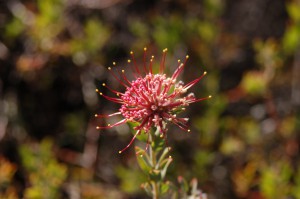Porcupine Hills: Naturally
Lying in the folds of a twisting valley, Porcupine Hills is the sort of place that makes you feel that perhaps, after all, the wild world is not completely in retreat.
Surrounded by the relentless wheat fields and orchards of the Overberg, this private nature reserve and guest farm preserves an area of renosterveld, an enigmatic vegetation type that has been all but exterminated by the arrival of mechanised agriculture.
Unlike fynbos, the vegetation that covers the craggy sandstone mountains of the Western Cape, renosterveld favours the fertile clay soils of the lowlands. In the past, these broad valleys were thick with grasses and heaved with wildlife – eland, red hartebeest, bontebok and zebra as well as their predators: lions, wild dog and spotted hyena.
The big animals are long gone but Porcupine Hills is a reminder of how things used to be. And thanks to the efforts of Cape Nature, you can now see for yourself on a series of newly-built trails that meander over several properties to create an exclusive and very unique hiking experience.
Chances are you’ll see the farm’s signature animals before you set off on a trail. No, not porcupines – you’ll be more than lucky to see one of these nocturnal and shy animals – but Verreaux’s Eagle, a pair have nested on the farm for over 15 years.
And there they were, gliding above us as we set off on a hike. I was with the Friends of the South African Museum, an amiable group of like-minded individuals who were keen to learn more about the renosterveld and whatever else came our way.
And the first thing that came our way was a steep walk up off the valley floor and onto the sandstone ridges that surround the farm. The grey-green scrub of renosterbos – the dominant species in renosterveld) gave way to fynbos plants such sugar bushes and great hedges of buchu that filled the air with their unmistakable lemon and liquorice smell.
The views started appearing as we gained height – we could see the Indian Ocean now – and the floral surprises kept coming: odd-looking proteas, some ground-hugging, others tall and bold, as well as flashy heathers (Ericas) and a droopy-headed Gladiolus. A flash of lilac-blue alerted us to an iris, member of a genus unique in the floral world in having an Afrikaans scientific name: Babiana, named for the baboons that enthusiastically dig up and eat their bulb-like corms.

Other treats were in store: we saw aardvark droppings (large, very sandy), evidence of antelope and porcupines and watched sunbirds and patrolling ravens. On the way down into the valley there were orchids to marvel at and the huge leaves of Poison Squills, a type of hyacinth, erupting out of the ground. Yellow-headed Oxalis flowers were in bloom too, one species of which is still a vital ingredient to that most traditional of Cape dishes: waterblommetjie bredie.
The hiking is easy; the trails have been sensitively built and follow the lines of the landscape, and there’s a whole range to choose from: you can take an hour’s stroll or spend most of the day out there. And with the Overberg’s growing focus on mountain biking and adventure, the hiking trails of Porcupine Hills fit nicely into a bigger outdoor experience. There is accommodation on the farm to suit all types and it’s little more than an hour and a half to get there from Cape Town, making it the perfect weekend destination, or even a day trip.
In a world of shrinking natural habitats and wildlife on the wane, it is heartening to see efforts being made not just to preserve nature but to showcase it too – otherwise how can we conserve what we don’t know? So hats off to the farm’s owners, Tony and Cha Davenport, who have opened up the secrets of the renosterveld to a wider public; with less than 5% of this vegetation type remaining, this is a conservation project that deserves the widest support.
And you never know: you may just see a porcupine.


